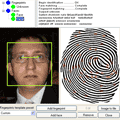Requirements for large-scale biometric systems
Nowadays the need for automated biometric identification systems is increasing in civil and forensic application fields. Fast and accurate identification becomes particularly critical for large-scale applications, such as passport and visa documentation, border control, voter registration and election monitoring systems, credit card transaction control and crime scene investigations. Many countries, including the US, European countries and others, incorporate biometric data into passports, ID cards, visas and other documents for use in large national-scale automatic biometric identification systems.
Automated fingerprint identification systems (AFIS) have been widely used in forensics for the past two decades, and recently have become relevant for civil applications as well. Large-scale biometric applications require high identification speed and reliability. Multi-biometric systems that incorporate face, fingerprint, iris and/or voiceprint recognition can now offer that as well as a number of other advantages such as improved identification quality and usability.
Large-scale automatic biometric identification systems have a number of special requirements, which are different from those of small- or medium-scale biometric systems:

- The system must perform reliable identification with large databases. Biometric identification systems tend to accumulate False Acceptance Rate with database size increase and the use of a single fingerprint, face or iris image for identification may become unreliable in a large-scale application. Several fingerprint images from person's different fingers or dual iris images will increase matching reliability. Multi-biometric technologies (i.e. collecting fingerprint, face and/or iris samples from a given person) will provide greater reliability. A fused algorithm is used to create a single identification decision based on the results of those multiple measurements.
-
The system must show high productivity and efficiency, regardless of its scale:
- System scalability is important, as a system may continue to expand and a high level of productivity should be available through the addition of units to the existing system.
- The daily number of identification requests could be very high for certain applications.
- Identification requests should be processed as quickly and efficiently as possible (ideally in real-time), requiring considerable computational power.
- Support for large databases (tens or hundreds of millions of records) is frequently required.
- The system must be generally robust and tolerant to hardware failures, as even temporary interruptions may cause system-wide problems in large-scale applications.
- The system must support the major biometric standards, thereby allowing the use of system-generated templates or databases across a variety of platforms, independent of the vendor source.
- The system should be able to match flat (plain) fingerprints against rolled as many institutions collect rolled fingerprint databases.
- The system must be able to work across a network as in most cases client workstations are remote from the server housing the central database.
- A forensic system must be able to edit latent fingerprint templates in order to submit latent fingerprints into the AFIS for the identification.
In addition to these requirements, the system price should be as low as possible.
Existing AFIS, many of which were designed specifically for criminalistics or other specialized application, are often quite expensive. Neurotechnology offers MegaMatcher SDK which includes technology and solutions for large-scale AFIS or multi-biometric fingerprint, iris, face, voice and palm print identification products. The MegaMatcher SDK meets all of the above listed requirements, at a competitive price.
